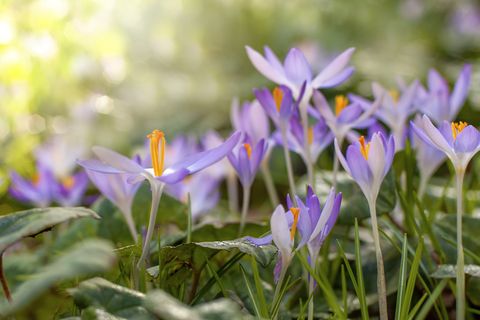12 Flowers and Vegetables to Plant in Fall
5 min read
Patrick DaxenbichlerGetty Images
What’s not to love about cherry blossom trees blooming or colorful meadows of tulips? While we know these plants are symbols of spring, much of the planting is done during fall! Although fall isn’t peak growing season, there is still a lot of opportunity to start planting in your garden or house containers. We know, it sounds counterintuitive but you’ll have a lot to look forward to when spring rolls around, trust us. So whether you are ready to graduate from your house plants or already have a small garden, these vegetables and flowers are perfect to plant in October.
From hearty greens like kale and arugula to delicate iris and tulip flowers, these will make great additions to your home for a pop of color or when whipping up a fresh salad with your earthy greens.
Whatever you decide to grow in October, be sure to read our list of tips for planting.
Kale
Depending on where you live in the country, you ideally want to plant kale six to eight weeks before the first fall frost. When it’s time to harvest, you can tell that kale is ready when it’s about the size of your hand. Then, all you need to do is break out the kale recipes!
SHOP NOW
Garlic
It’s a good idea to be planting garlic in October as you want to develop the roots before the freezing months. Prepare the soil by removing weeds and be sure to plant your garlic in an area that receives about six to eight hours of sunlight.
SHOP NOW
Arugula
If you live in a warmer region, you can plant arugula in October and see young leaves six to eight weeks later. You’ll want to harvest your arugula when the leaves are younger, as older leaves tend to be a bit tough. You can even try this arugula-kale harvest salad with your freshly grown vegetables.
SHOP NOW
Shallots
Shallots are part of the Allium family, including onions, garlic, chives and others. Growing shallots does best in warmer areas when planting in fall because they prefer soil temperatures of 35 to 90 degrees Fahrenheit. When it’s time for planting, their cloves are placed in the soil (thicker part pointing down) with the top just peaking above the soil line. After 90 days, you’ll know when it’s time for harvesting when their tops begin to turn brown.
SHOP NOW
Peas
Peas are grown during the cooler months and are very easy to grow. For warmer areas in the country, they can be grown during fall or when the soil is cool. When planting, sow the seeds one to two inches deep in the soil and two inches apart. Also, you’ll want to make sure you grow them in plenty of sunlight — they will taste sweeter!
SHOP NOW
Tulips
These bright color petals are the quintessential flower of spring. You can start planting tulips in the fall when average temperatures are between 40 to 50 degrees Fahrenheit at night. This is because tulips need colder soil to develop their roots for spring. Although the flower bulbs can hold up well, you’ll want to avoid soggy soil because the roots will rot quickly.
SHOP NOW
Daffodils
If you are new to planting flowers, daffodils make a great option because they are easy to grow and are very durable. Plant two to four weeks before the ground freezes and pick an area that gets full or partial sun. After they are planted and they begin to bloom, cut the flowers, and put them in a vase by themselves. You’ll want to keep them apart from your other fresh flowers because daffodils secrete a liquid that causes other flowers in the vase to wilt.
SHOP NOW
Pansies
Known as the flowers with “faces,” pansies make great décor for windowsills. With just a little bit of potting soil, pansies can grow in containers with the right amount of sunlight (not too much). If your pansies are not doing optimal, they are often under watered, so make sure they are getting enough H2O.
SHOP SEEDS
Crocuses
Crocuses start blooming during winter, even when there is snow on the ground. For the biggest impact, plant crocuses in clusters instead of in a straight line, and be sure they are planted before the first freeze.
SHOP NOW
Iris
Irises have a very delicate and colorful look to them. They are typically planted when temperatures are between 40 to 50 degrees Fahrenheit, and need a good deal of sun to bloom beautifully. One important note is that you don’t want to bury your Irises too deep, they should be planted close to the surface for best results.
SHOP NOW
Hellebores
Hellebores are ones to poke through the snow during late winter. There are two popular varieties: the Christmas Rose has white petals and blooms in warmer climates and the Lenten Rose that takes on a pink/purple color. Due to their early blooming nature, Hellebores like to be kept in the shade or partial shade, along with well-drained soil.
SHOP NOW
Flowering Cherry Tree
Flowering cherry trees are most known for their pink buds that bloom towards the beginning of spring. Although we all know these as spring trees, early fall is the best time to plant bare-root flowering cherry trees. For best results, these trees should have plenty of sunlight, grow in a spot with minimal wind and not be exposed to extreme weather.
SHOP NOW
This content is created and maintained by a third party, and imported onto this page to help users provide their email addresses. You may be able to find more information about this and similar content at piano.io
















